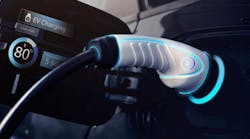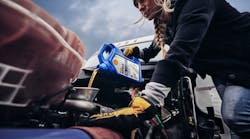The memories of last winter – the Polar Vortex, blowing snow and temperatures on the wrong side of zero – no doubt won’t soon be forgotten. If you believe the Old Farmer’s Almanac, this winter east of the Rockies will be very similar.
Harsh winters translate to high use of road salts and liquid deicers. Cold air can take your breath away, but road salts and deicers can take your rig away, and right into the repair shop.
Being prepared for Old Man Winter can add service life to your fleet. Here are a few ways to stay ahead of the corrosion.
LIQUID DEICERS
Corrosion concern is worse today with the magnesium chloride and calcium chloride liquid deicers being used on roadways. These liquid deicers can find their way into a vehicle’s cracks and crevices and stay there. Plus, they love to absorb water and will stay wet much longer then old- fashioned sodium chloride rock salt.
Metal, oxygen and an electrolyte (water, or worse, salt water) creates a hotbed to breed corrosion. Subsequently, the longer the deicer stays wet, the longer it can do damage.
A good prevention step is to think like water and use caulks and non-absorbent materials to fill gaps and crevices where standing water can accumulate. Focus your repairs 48” from the road and below, as this is the hot zone for corrosion. This area gets the most road spray and backsplash of water and deicers.
DON’T LET BODY DAMAGE GO
While accumulation points need to be eliminated, body damage needs to be repaired before the winter months as well. Any exposed metal that was at one time painted needs to be brought back to its original condition.
The exposed metal will be the first to be damaged, and this destruction will happen quickly if not repaired with a high-quality automotive primer and topcoat. Make sure you are using metal preparation and application procedures as outlined by your coating supplier. Also confirm that your paint supplier has tested their coatings with the most advanced corrosion testing methods and have moved on from American Society for Testing and Materials (ASTM) B117 Standard (salt fog test), which has proven to be a very poor correlation – perhaps even negative – to real world corrosion.
AVOID GALVANIC CORROSION
Examine areas on your fleet where dissimilar metals are touching. These are galvanic corrosion hot spots.
The worst and unfortunately the most common combination of dissimilar metals found are aluminum and stainless steel. When in contact with each other, they act just like a battery where electrons flow from the aluminum to the stainless steel. In this scenario, the aluminum will corrode extremely fast, leaving behind a white dust of aluminum oxide.
Ironically, the stainless steel will be pristine and have extra life thanks to electrons the aluminum has so graciously donated.
Yes, aluminum can “rust.” Any metal can rust. Often, the rust or oxidation is not the red rust we are accustomed to see on steel, but a clear or white color.
These areas of galvanic corrosion are preventable by redesigning the hinges or fasteners, or placing non-conductive insulators between the dissimilar metals. Just painting over them is adding a longer fuse to a problem waiting to explode.
REGULAR MAINTENANCE A MUST
Every fleet should have a maintenance schedule that includes cleaning inside and out. More than running through a simple car or truck wash, fleets should focus on the five factors important to exterior cleaning of the under chassis and body:
- Water quality. The fewer dissolved solids, the better. Too much calcium or magnesium in the water makes it “hard” and that can reduce the cleaning power right off the bat.
- Temperature. The higher the temperature, the better the cleaning power. A best practice is to keep the cleaning solution between 100 and 120 degrees F. Higher temperature water, detergent, vehicle parts, even warmer ambient air temperatures all have higher energy and are better for cleaning. When matter is heated, it is in a more excited state and molecular movement is then increased. This extra movement or vibration aides in cleaning.
- Time. More specifically, “dwell time” – how long the active chemical is in contact with the metal during cleaning. The longer the contact time, the better.
- Mechanical action. This is the amount of force the detergent mix hits the surface. Also called impingement, it can be the force applied by a cleaning brush or the water pressure.
- Chemical action. Most importantly, when it comes to cleaning and removing salt and deicers, the proper chemical action needs to be created. Classic detergents can encompass road dirt, oil and soil, and then need to lift and remove them. One critical point of detergent choice is pH. A low pH (less than 7) detergent can solubilize the salts to remove them, while detergents at other pH levels do not accomplish this. Low pH detergents also have the benefit of actually helping prevent corrosion when not fully rinsed off almost leaving a coating behind.
BENEFITS
Your fleet is a moving billboard of your brand and seen by millions every year. As such, you need to make the best impression possible.
Take some time this fall to prepare your fleet for the winter and fight corrosion before it settles in. It will not only save face for your brand, but it will extend the life of your fleet, as well as save you time and money.
Dan Szczepanik is the global product manager, fleet and manufacturing for Sherwin-Williams Automotive Finishes (www.sherwin-automotive.com), a manufacturer and distributer of a complete line of advanced technology paint and coating systems for automotive and fleet refinishing industries. It is a division of the Sherwin-Williams Company (www.sherwin-williams.com), one of the world's leading companies in the manufacture, distribution and sale of coatings and related products to professional, industrial, commercial and retail customers.




